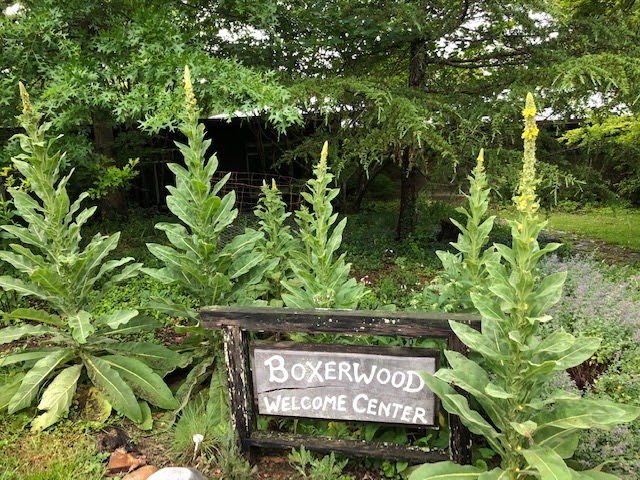
Common mullein is a non-native plant in Virginia, and as with many non-natives, we’ve had to make a decision at Boxerwood: should it stay or should it go? As you can see from the photo above, for the time being we have decided to let it stay.
Mullein is reported to have many medicinal uses (as an analgesic, antihistaminic, anti-inflammatory, anticancer, antioxidant, antiviral, bacteristat, cardio-depressant, estrogenic, fungicide, hypnotic, sedative and pesticide), and research seems to confirm some of these claims. I had heard it was utilized medicinally by Native Americans, and I assumed it therefore must be native. But although it does seem to have been adopted by native peoples, it was introduced to North America by Europeans in the 1700’s. In addition to its medicinal uses, settlers in Virginia used the toxic seeds in “fish stings”: the seeds were crushed and put into diked areas of slow moving water. Fish respiration was severely reduced or stopped by the toxic seeds, and the fish were easily harvested. Subsequently, mullein spread so quickly and so widely that some American botanists in the 1800’s also assumed it to be a native species. It can now be found in all 50 US states, and on every continent other than Antarctica.
Why have we let mullein grow here?
- To begin with, we are not too worried about it out-competing native plants. It is not an aggressive species, and grows only in disturbed soil, rarely persisting beyond the first few post-disturbance years. However, we won’t let it go to seed here, because each plant can produce 100,000 seeds, and the seeds are viable for up to 100 years.
- Mullein adds visual interest (this is clearly subjective, and perhaps not all will agree), and the bloom patterns on the stalk are fascinating to observe as they develop throughout the summer. Each individual flower lasts for only a day, and they open from the bottom of the stalk toward the top in successive, overlapping spirals.
- We want to support pollinator health at Boxerwood, and we have observed numerous pollinators visiting the flower stalks. (Although I must acknowledge that this too is controversial: some studies indicate that pollinators feeding on non-native plants exhibit reduced fitness.)
All in all, I find common mullein to be an interesting, useful, and beautiful plant, and I hope it adds to the beauty and resiliency of the Boxerwood landscape.
